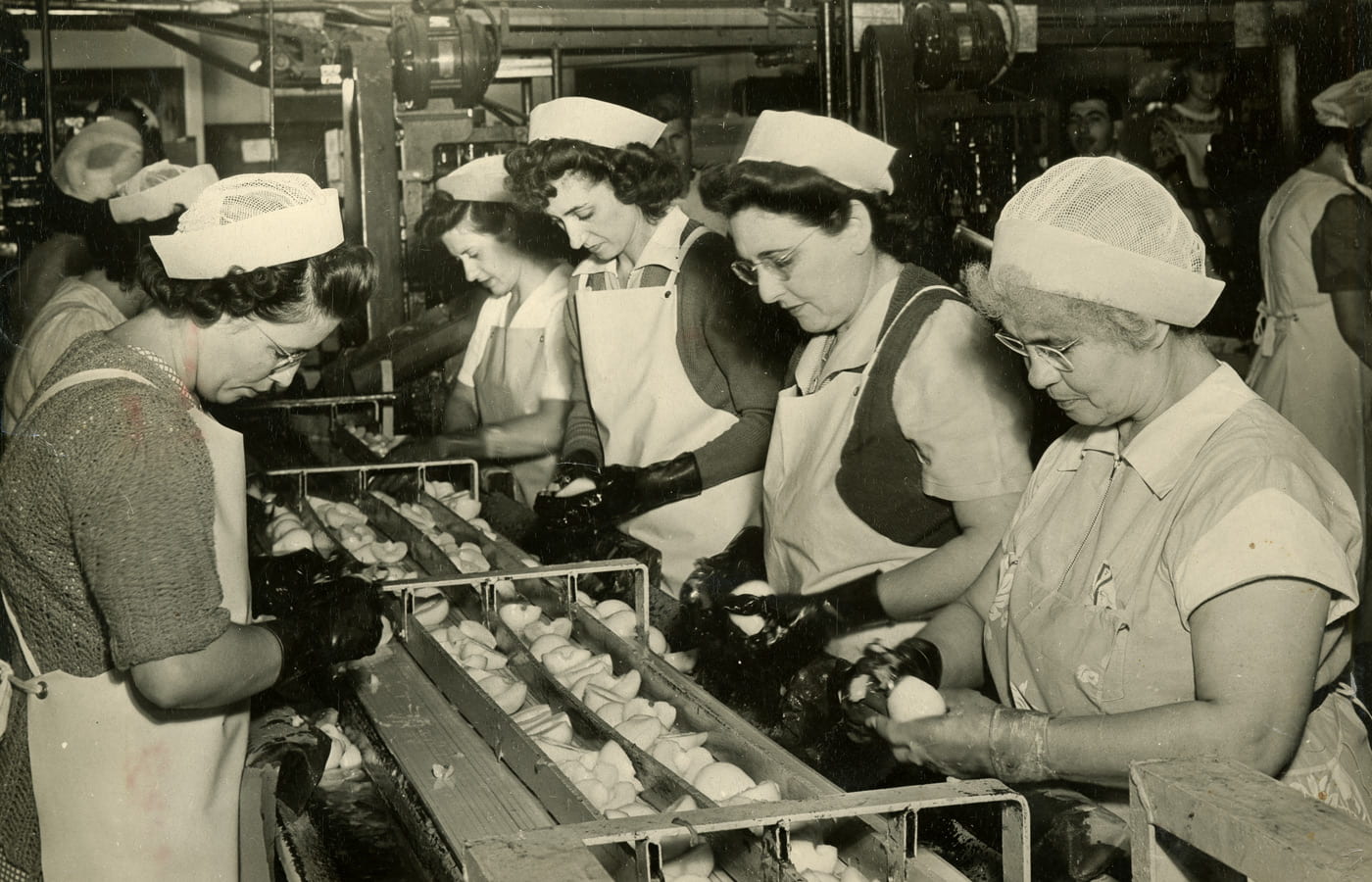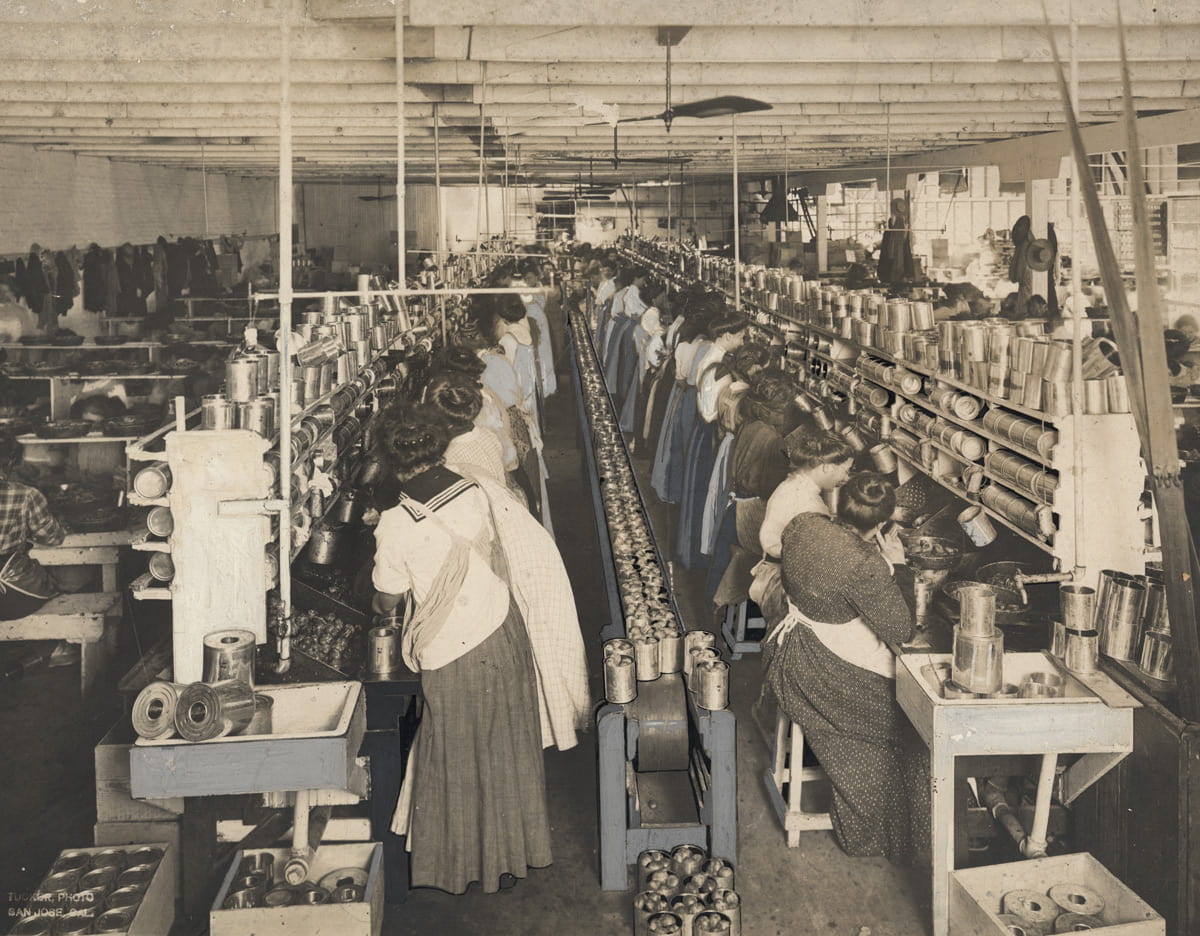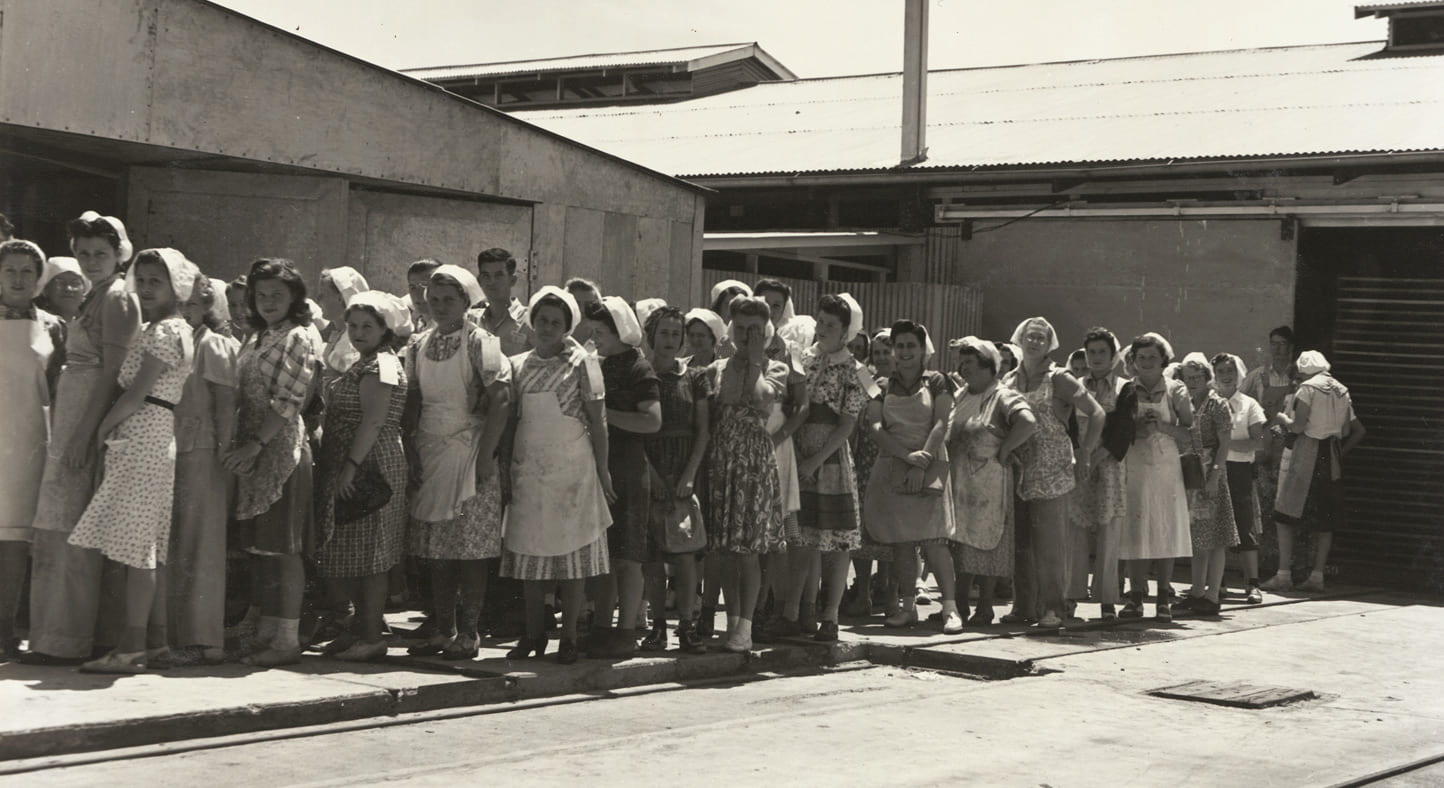The San Jose Fruit Cocktail: Canneries, Civil Rights and the Birth of Silicon Valley

Cannery workers, c. 1940 (2004-17-338) Female cannery employees on assembly line preparing pears for canning. J. C. Gordon, photographer. From the Leonard McKay Collection. Courtesy of History San Jose.
In her last semester at San Jose State, Margarita Garcia Villa, ’08 History, took a public history course with lecturer Margo McBane that introduced her to an entire generation of former San Jose cannery workers. Though she had spent years in San Jose, Garcia Villa was unfamiliar with the impact of the canneries on the local workforce—especially for women and people of color from the early 20th century through the civil rights movement until the last of the canneries were forced to close in the 1990s. McBane hired Garcia Villa to assist in a research project that investigated the economic and cultural impact of the canneries on Silicon Valley—formerly, the agricultural mecca that was the Valley of Heart’s Delight. Together with McBane, McBane’s historian partner Suzanne Guerra, and a few other students, Garcia Villa collected oral histories of former cannery workers in English and Spanish.
“Before Santa Clara County was Silicon Valley, the canneries were the main source of opportunities for people to earn an income,” says Garcia Villa, who has taught Spanish at East Palo Alto Charter School since graduating from SJSU. Canneries dominated the region for nearly 100 years, starting in the late 19th century. “Everyone I talked to said that working at the cannery gave them a sense of pride—they were feeding the country.”
More than 100 years after the passage of the Nineteenth Amendment to the U.S. Constitution, which guaranteed women the right to vote, McBane, Guerra and Garcia Villa maintain that San Jose canneries inspired diverse communities to organize, advocate and use their voices. As the cityscape of Silicon Valley grows ever taller, McBane and Guerra argue that it is more important now than ever to understand the canneries’ economic, cultural, political and social impact.

Cannery workers, c. 1905 (1993-101-38) Early women cannery workers. This image shows the beginnings of mechanization in the factory. The women are working with the fruit by hand, with crates of cans below or next to their workstations. Filled cans are carried out of the work area on a small conveyor belt. Photo by Tucker Studio. Courtesy of History San Jose.
Documenting History
McBane and Guerra, as public historians, first learned about the canneries’ influence when they were contacted by History San Jose when the city made plans to tear down the cannery buildings in downtown San Jose in the late 1990s. The developer was required by the California Environmental Quality Act to document the historical sites, so they hired History San Jose to create the exhibit and McBane and Guerra to research and record the historical significance of the canneries. Together they pored over Sanborn maps of the region, which revealed the neighborhood populations around the turn of the century, to determine who worked in the canneries and where they lived. They created an interactive online exhibit featuring photographs, video interviews, timelines and archives that include the voices of cannery workers. When they began interviewing former workers, many of them women in their 60s, 70s and 80s, McBane and Guerra realized how much the canneries represented, not just to the city’s economy, but to the workers themselves.
“More things are undocumented for different groups within the community than people who are undocumented citizens,” says Guerra, who worked as a museum curator before becoming a public historian. As part of their research, McBane and Guerra scanned dozens of family photographs depicting cannery conditions. These artifacts included images of the workforce—immigrants from Italy and Portugal, and later from Mexico, Central and South America, many of them women—operating machines, forklifts, sorting and canning fruit. “A lot of the cannery workers that we interviewed brought up their involvement in civil rights, environmental justice, women’s rights … while working in the canneries they learned how to organize, advocate and speak publicly.”
Not only did the canneries provide on-the-job leadership and advocacy training for workers, they provided a stable source of seasonal and year-round income. This made it possible for generations of people of color, especially Mexican-Americans after World War II, to establish roots in Silicon Valley. McBane and Guerra say that families who had previously been forced to follow seasonal work with the crops were able to purchase homes and seek educational opportunities for their children.
Garcia Villa was recruited by McBane and Guerra in part because she could translate the life stories of Mexican-American cannery workers who dedicated decades to the San Jose Del Monte cannery and its predecessors, the California Packing Corporation, the California Fruit Canners Association and the San Jose Fruit Packing Company. Del Monte’s Plant Number 3, located on Auzerais Avenue and San Carlos Street, operated from 1893 to 1999 and employed generations of workers—often immigrants, people of color and women who were typically excluded from other industries. As Garcia Villa says, the same people who “fed” Silicon Valley helped establish the neighborhoods that have made San Jose the city that it is today.
“From the 1970s onward, when all the national civil rights legislation was happening, canneries really impacted women because they were no longer stuck on the line,” says McBane. “They could actually work in forklift operations and supervise other workers. With the unions coming on strong in the ’70s, they earned vacation time, pensions and healthcare, they went on to college. Women learned to speak up for themselves and advocate for their families, themselves, their communities. They became involved civically. Leadership within the canneries correlated with leadership within the community.”

Eastside Plant, San Jose, c. 1935 (2003-22-21-60) Fruit cutters lined up for cutting equipment, San Jose Eastside Plant. From the Burrel Leonard Collection. Courtesy of History San Jose.
Capturing Living History
McBane and Guerra’s research earned SJSU’s first National Endowment for the Humanities grant, which gave them a budget to hire students, interview workers, scan and archive historical documents. Anne Fountain, San Jose State Professor of World Languages and Literatures, was co-principal on the grant. They partnered with Kathryn Blackmer Reyes, SJSU librarian and director of Dr. Martin Luther King, Jr. Library’s Africana, Asian American, Chicano, and Native American Studies Center (AAACNA), to host a series of public community conversations with cannery workers in 2017. Blackmer Reyes, an expert on Chicano/a Studies and race studies, believes that it is important for members of the public, especially residents of Silicon Valley and SJSU students, to understand the canneries’ historic significance.
“Canneries allowed for what was a predominantly minority community to prosper,” says Blackmer Reyes. “That was true for the automobile industry in Detroit or steel in the Midwest, where labor was a place for families to economically stabilize and buy homes. McBane and Guerra are providing really crucial conversations given where we’re going economically in Silicon Valley. It’s important to share the stories of the cannery workers to help them understand that they have value—they are living history that has to be documented. We need to make these stories, photographs and resources available to the public in some way for people to understand not only where we are from, but where we are going.”
Though AAACNA does not have special collections, Blackmer Reyes has scanned and digitized historic documents, all of which are available and free to the public on the library website. Through her partnership with McBane and Guerra, she hopes to disseminate their findings through the library. The historians are establishing a bilingual website to organize their video and oral histories, photographs and archives in English and Spanish. Their goal is to create a space where people can hear from cannery workers in their own words to truly understand the impact that the industry had—and in some ways, continues to have—on Silicon Valley.
“When is something historically significant? We often don’t know the stories behind historic sites until they are gone,” says Guerra. “Sometimes they are gone before they were archived. Women’s history existed before Women’s History Month; African-American history existed before Black History Month. I see our project as creating documentation for those different parts of history.”
Carrying Stories Forward
Garcia Villa is now in her 11th year teaching Spanish in East Palo Alto, where she incorporates local history into her lessons. She is also pursuing her master’s in Mexican American Studies at SJSU, where she is writing a thesis on recipe and the origins of ingredients from her native Mexico. She occasionally consults with McBane and Guerra, helping conduct interviews in English and Spanish with cannery workers.
“All the practical training in conducting research that I learned from Margo directly correlates to the work I am doing now,” says Garcia Villa. “It gave me the confidence to know that I can do this—pursue a master’s, teach full-time and raise my child—and write about my community.”
She encourages Silicon Valley residents whose families worked in the canneries to reach out to McBane and Guerra to document their stories, especially as development in San Jose shifts the city’s economic and cultural landscape.
“It’s really important for people to really understand what was on their land before they purchased their home or bought a condo,” Garcia Villa says. “A lot of them have been built on the sites of former canneries. Unless there are historic markers, they may have no idea of the canneries’ impact. People can demand that their public institutions, libraries and museums showcase that history, because it is important not only locally, but nationwide. The canneries fed the country and mobilized generations.”




We Los Chicanos Hijos de Campesinos must always remember while we were being poisoned in the fields of Sal Si Puedes WE were being Killed in the fields of Vietnam.WE were good enough to go fight for Democracy in Vietnam yet were denied Democracy here in San Jose yet it was Our body and our Childrens body that produced the wealth.It is Time that this city reckon with its brutal treatment of Chicanos in this City.As a SON OF SAN JO myself it is my duty responsibility privilege to fight for what my Ancestors were systematically deprived of Due process and Equal Protection under the law.Redlining and the Racist Restrictive covenants that created this beauty is illegitimate in the sense that Legally one cannot profit from that which is inherently Illegal Immoral unethical Inhumane.If One says I am not good enough to live next to him or good enough to go to school with him he is saying consciously or subconsciously I do not deserve to exist.This is Genocide.There is proof that those deeds in that area explicitly outline the discriminatory practice that created this romantic beauty you claim.Question is why are you so comfortable with this fact yet call yourselves human kind compassionate???
My Grandmother worked in the canneries and she would have loved to see this story told. Thank you.
Valerie: Kathryn Blackmer Reyes (Director of AAACNA SJSU Library) and I just received a large grant from the Santa Clara Valley Board of Supervisors to create a website/portal (including online exhibits) of the larger story “Before Silicon Valley: A History of Mexicans in Santa Clara Valley, 1920-1960”. The SJSU Library will be hosting the website. If you have any pictures of your grandmother at work or home during those years, please contact me. Once the shelter in place order is over we would love to come and scan the photos and have your or your mom’s explanations of them (at a social appropriate distance, of course). Just contact my email margo.mcbane@sjsu.edu
I am interested in helping with this project and adding the Packing Plant at Sweet Briar Orchard on North First Street which owned by the Chinchin Family.
This ranch/orchard was
The largest pear and apple orchard in The Country of Santa Clara. Pears were picked and immediately washed, sorted wrapped by hand and driven to Refrigerated Barns on 13th .
Our family lived ther and my father managed the orchard/ranch. I also worked in Libby’s on Matilda in Sunnyvale…putting cherries I. Cans…they would end up being fruit cocktails. I have lots of stories and k ow women who are now in 90’swho worked their.
Irma Balderas
408. 912-6697
Thank you so much for taking the time to write this story. I hope lots of folxs read it and learn about the rich history of the Santa Clara Valley. There’s more to it than our tech story.